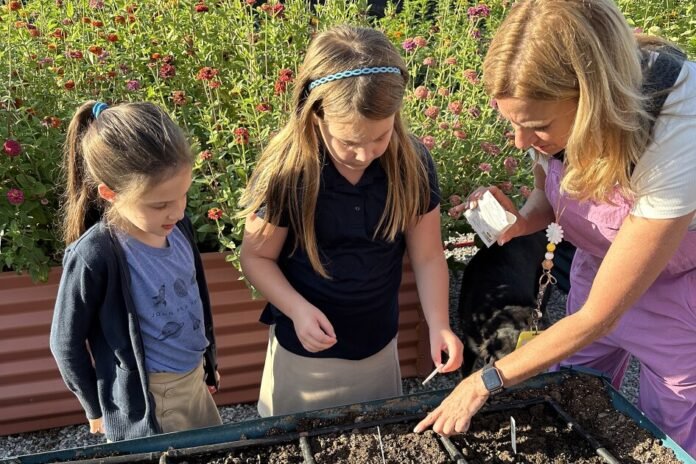It may sound counterintuitive, but school gardens can offer students fertile ground to learn about technology, from using generative artificial intelligence tools to operating hydroponic or water-based growing systems.
That’s why the John Rex Charter School in Oklahoma City, which serves grades pre-K-8 with a focus on technology, has invested in creating a state-of-the-art school garden that features extensive use of technology.
Ally Audas, the school’s enrichment specialist, is informally known as the school’s “gardening teacher.” She makes the case that gardening is important for students living in the digital age, because it teaches them to see beyond instant gratification and understand that developing meaningful things usually takes time.
“With technology, you get what you want right now,” she said. “When we go and use the garden, you plant a seed and you aren’t going to harvest anything for months, potentially. They have to really nurture things and learn some grit, some hard work, and some patience. It’s a great life skill that I think a lot of kids don’t get right now.”
Audas, who formerly worked as a technology specialist, was scheduled to present at the ISTELive 25 + ASCD Annual Conference 25 in San Antonio June 29 to July 2 on how to use new technologies to engage students in the age-old agricultural arts.
In Audas’ school garden, called the John Rex Urban Garden Lab, there are 33 raised beds, four hydroponic gardens, bird and insect feeders, and a large greenhouse that was designed by architecture students from the University of Oklahoma. Many of her students come to her class with little knowledge about how to garden because they live in urban areas where those opportunities are scarce.
Audas assigns every student a vegetable, an herb, a flower, and a berry to become expert on. They then use an app called Seed to Spoon to research everything their plants need—from light, to water, to protection from common pests.
How to use ChatGPT for garden-oriented academic lessons
This year, Audas started having her students use generative AI programs such as ChatGPT to plan their gardens in the most efficient ways. The tech tool is good for examining all the various gardening methods that Audas’ classes use. Those methods include how to position plants together so they will benefit one another; how to plant crops on a grid system to maximize the space; and how to make plant care decisions based on the local climate and the height of the plants.
“We got on ChatGPT and said, ‘plan 33 four-by-eight raised beds,’” Ausas said. “The students came up with all the questions that we would need to know, and then we let ChatGPT plan the garden. And we talked a lot about ChatGPT—‘well, you guys are very knowledgeable, so we’re going to put it in there, and you’re going fact-check this.’”
During the winter months, students continue growing plants in the school’s hydroponic beds, a technology that allows the students to grow plants in small, indoor spaces without using soil.
With every activity and project, students are collecting data and comparing various growing methods and environments, Audas said. She has her students make their own resource books with everything they’ve learned about their plants both from their research and their observations.
“One of my [student] pairs had strawberries as their plant that they were the expert on,” she said. “We’re checking all their research, and under common pests was [listed] kindergartners. I said, ‘Why do you have this?’ And they said, ‘Well, our strawberry patch is right where the kindergartners walk by for P.E. and they eat them all.’”
Instead of a book next year, Audas plans to have her students make their own plant resource app, a project she said she’s tackled with students at a school she previously worked at.
The students also grow a pollinator garden for birds and insects. In it are special feeders with cameras connected to an AI program that identifies the different species. Whatever creatures visit the feeder are then live streamed into Audas’ classroom, where she plans to have next school year’s students start collecting data on all the birds and insects that visit their feeders.
The school also participates in a monarch butterfly tagging program that allows students to track the migration of the monarchs that visit their garden and then travel all the way to Mexico.
Taken together, these various projects help instill in students how technology underpins much of modern life, even in something as basic as growing food, Audas said. And the school garden gives students an opportunity to apply their technology skills in an environment they love: the outdoors.
“We can say, ‘Hey, here are your seeds, we’re going go plant them. Let’s see what happens,’” Audas said.
“But you can make a semester-long lesson out of anything in the garden. It just depends how far you want to go with it,” she continued. “I have yet to have someone come to me with a math lesson or a science lesson that I can’t say, ‘oh, here’s how we’re going to do that in the garden.’”






